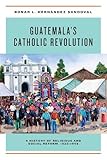Guatemala's Catholic revolution : a history of religious and social reform, 1920-1968 / Bonar L. Hernández Sandoval.
Material type: TextPublisher: Notre Dame, Indiana : University of Notre Dame Press, [2019]Description: 1 online resourceContent type:
TextPublisher: Notre Dame, Indiana : University of Notre Dame Press, [2019]Description: 1 online resourceContent type: - 9780268104443
- 0268104441
- 9780268104436
- 0268104433
- 0268104417
- 9780268104412
- Catholic Church -- Guatemala -- History -- 20th century
- Catholic Church
- Church and state -- Guatemala -- History -- 20th century
- Christianity and politics -- Guatemala -- History -- 20th century
- Église et État -- Guatemala -- Histoire -- 20e siècle
- Christianisme et politique -- Guatemala -- Histoire -- 20e siècle
- Christianity and politics
- Church and state
- Guatemala
- 1900-1999
- 282/.72810904 23
- BX1438.3
- online - EBSCO
| Item type | Current library | Call number | URL | Status | Notes | Barcode | |
|---|---|---|---|---|---|---|---|
 eBook
eBook
|
Biblioteca "Angelicum" Pont. Univ. S.Tommaso d'Aquino Nuvola online | online - EBSCO (Browse shelf(Opens below)) | Online access | Not for loan (Accesso limitato) | Accesso per gli utenti autorizzati / Access for authorized users | (ebsco)1862308 |
Includes bibliographical references and index.
Papal power and church-state relations -- The romanized church -- The resurgent church -- The missionary church -- The reformist church -- The progressive church.
"This book examines the emergence of progressive Catholicism in Guatemala and the interaction between clerics and indigenous Mayan communities. By the 1920s, the Guatemalan church (whose power was diminished by the anticlerical reforms of the nineteenth century) reemerged as a temporal political force. This revival was fueled by the expansion of papal power, the proliferation of Church-sponsored lay organizations, and immigration."--Provided by publisher.
Description based on print version record and CIP data provided by publisher.


